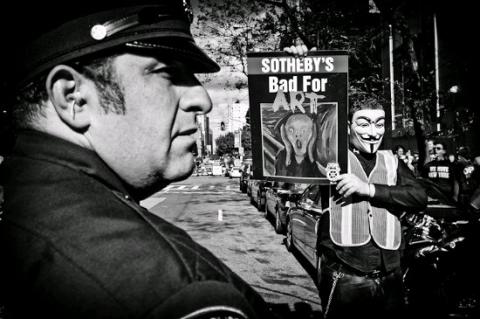Occupy Wall Street Infiltrates the Art World

Occupy Wall Street has grown far beyond the boundaries of Zuccotti Park in the last two months, gaining the support of citizens all over the nation who find themselves banding together to speak their minds about this country's growing income gap. Indeed, the inclusive rhetoric of the movement, which positions 99 percent of the population as victims of the greed of the top 1 percent, has elicited broad support.
There is, perhaps, no greater venue for illustrating exactly how vast a disparity exists between the haves and have-nots right now than at the sale of million-dollar artworks. Lending support to the gathering of disgruntled art handlers who have been locked out of Sotheby’s auction house in New York since August, Occupy Wall Street protestors have made things very uncomfortable for the auction house and its clients during the two biggest sales weeks of the year.
Last Wedenesday’s (November 9) Impressionist and Modern Art sale was held amidst tensions created by the raucous protestors in front of the Sotheby’s headquarters on York Avenue. Collectors (read the 1 percent) arrived to the evening sale to find the grotesque inflatable rat favored by unionized New York City picketers surrounded by a mob of horn and whistle blowers. Sotheby’s staff attempted to usher clients and press into the building as expeditiously as possible; however, many were the recipients of verbal abuse.
Just before the sale's 7p.m. start, several protestors rushed past the security in front of the entrance and parked themselves on the floor of the Sotheby’s atrium. Blowing whistles and shouting “We are the 99 percent,” the occupiers succeeded in grabbing attention, as the lobby activity came to standstill. Police were called, and the protestors were removed from the property. That did not stop the gathering out front from disrupting the sale. Throughout the duration of the auction, noise from the protests carried all the way up to the seventh floor saleroom. Collectors, however, were not deterred from buying: the sale brought in $199.8 million.
A week later, the Sotheby’s labor dispute continues, and the OWS movement was out in even greater numbers to protest the Contemporary Art evening sale. The gauntlet of rowdy demonstrators provided excitement, as the super-rich made their way past them and into the auction house. An NYPD spokesman confirmed that nine occupiers were arrested in connection with the protests. Again, buyers were seemingly unfazed by the unrest downstairs and bought voraciously. The evening’s sale was the third-biggest Contemporary sale at Sotheby’s ever, totaling $315.8 million.
The OWS movement has succeeded to the extent that it has due to its broad appeal. Many Americans are experiencing the strain of the job market and the sour economy, and believe that something needs to be done to fix it. The ideas have gained such traction in the media and among politicians because the protestors have (for the most part) managed to avoid becoming vitriolic. The symbolism of occupying Wall Street has sent the message that regulation of the financial sector is long overdue. The voices of the 99 percent are heard when they are used to engage in reasonable and rational debate.
The protestors who were arrested last week and the others who shouted angrily at the art collectors as they entered Sotheby’s were not attacking a flawed system. The mean-spirited crowd resorted to bullying instead of sensible protest. In doing so, they were missing their mark. Far from Wall Street, the complaints of the demonstrators were no longer directed at flawed financial regulation, but were instead formed of resentment of wealth.
The situation we are facing as a country is infuriating to be sure. However, change and compromise will only come from respect. The Occupy Wall Street movement has taken on an importance that no one could have foreseen. The opportunity to stand up and be heard is very valuable, and as long as the media remains interested, occupiers should weigh their actions very carefully. The 99 percent need to choose their battles wisely in order to see this through to the end.






























































































































































































































































































































